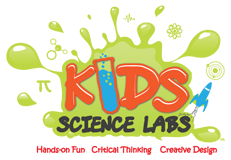It’s no secret that kids love dinosaurs, volcanoes, slime, and good food. The real question s how can we combine the things we love with some basic science and a wonderfully motivating question that makes kids think hard about how the world works. We teach Volcanoes through our Environmental Science series, Climate Change series, and in camp we often combine Chemistry and Physics to make Volcanoes go so far beyond what kids know. Kids are curious, so let’s share what we did on this day full of cloudy land formation at KSL. On this camp today, we put it together for young scientists and explored more of the world of Volcanoes.
Oil, Water, Dish Soap, Citric Acid, Baking Soda can make a Lava Lamp real in this classic KSL Camp Volcano
We start our day by exploring volcanoes, and start by letting our young scientists teach us what they already know. Rather than force knowledge into them, we instead collaborate and build on their beautifully simple understanding of the world around them. After hearing about magma, lava, explosions, and volcanoes, we quickly ask “but have you ever held a piece of a volcano in your hand?”. In this opening Kids Science Labs hands-on science experiment in camp today, we investigating the porosity and permeability of real volcanic rock. Each child was given lava rocks and asks to investigate them to determine if they are brittle, abrasive, and then whether they can actually break them apart. Often young kids don’t even know that volcanoes, because of the constant heating and cooling, create very porous, brittle rock formations, as gases are released and the cool air cools the lava to form not so dense rocks. These rocks are very different than marble, or the pebbles in Chicago or Seattle. In class today, we tested how the rocks responded to vinegar, water, and other liquids, to provide context for the characteristics of the volcanic rock itself.
Now that kids have a chance to break some lava rocks, which we can share is pretty fun for all ages, we move on to understand basic land formation, using family staple, you guessed it….graham crackers. Tectonic plates seem so hard to understand given the scale problems of the Earth, so we have kids use brittle graham crackers to see what happens when “two tectonic plates move together”….land moves up. For our youngest students, its an opportunity to also build fine motor skill development with real science tools like a pipette. To kids, it just super fun and informs them about how land forms.
As we really start to hear their observations and questions about what they are seeing, we try to break a common misconception, that a volcanic eruption is a chemical reaction. That fact is that it was magma and air before and its magma and air after, and that’s a physical reaction. To enable kids to deeply understand the difference, we use a KSL favorite, jelly marbles or what we call sodium polyacrylate spheres, to actually help kids feel PRESSURE REACTIONS that result in lava erupting. You place the jelly marbles inside two different sizes of syringes an simply squeeze. I can’t tell you how many ways this is loved by kids and the learning outcomes are incredible as they have to push really hard to turn the jelly into jam, as the opening of the syringe is really small…..thus they better understand how a volcano erupts (the earth has to push up or squeeze the lava out).
Kids Science Labs enables kids to learn how pressure works for Volcanic Eruptions
As our kids in camp learned and explored, it was now time to experience Volcanic Eruptions at a level that is exciting. We use a basic science experiment using citric acid + baking soda, in an aqueous solution (water) that we call Test Tube Volcano Poppers. Kids love it and can now “feel the eruption”. They want to do it time and time again. While I didn't capture the live video today, you can see this video from pre-Covid 2019 of the experiment to get the gist.
Volcano Test Tube Poppers Pre-Covid 2019 Video (we wear masks all day now with our KSL Health Protocols)
Our oldest kids combined the chemistry from earlier in the week, where we explored Physical vs. Chemical Reactions, and then applied it to Volcanoes, which was wonderful to see as kids are great at applying what they learn. We finished the day with a series of experiments to help kids design real volcanoes, experiment with making their own lava by building viscosity (thickness) of fluids, and of course, exploring a most basic lava forming reaction.
At home fill a clear cup with 4 oz of oil, 2 oz water, drop of food coloring, dish soap + half alka seltzer tablet
In the afternoon, we used some time to make a volcano, in some cases, we added texture to the exterior of the volcano, by using calcium carbonate (plaster of Paris), and allowed our students to make their own volcano.
We appreciate that your kids are with us to explore Volcanoes, Pressure, and Liquid Chemistry on this camp day and are glad to be able to frame questions that allow kids to explore the science by adjusting a simple question that they can’t answer easily. IS it possible for a Volcano to explode with Cloudy Meatballs? It sounds preposterous, but that’s exactly how you can stretch the brain, improve mental recall, and better understand that no, Volcanoes explode with gases, hot rocks, and whatever is under the earth, as the pressure pushes everything up. Enjoy your day. Be safe. Thanks for another great day of hand-on science at Kids Science Labs.









